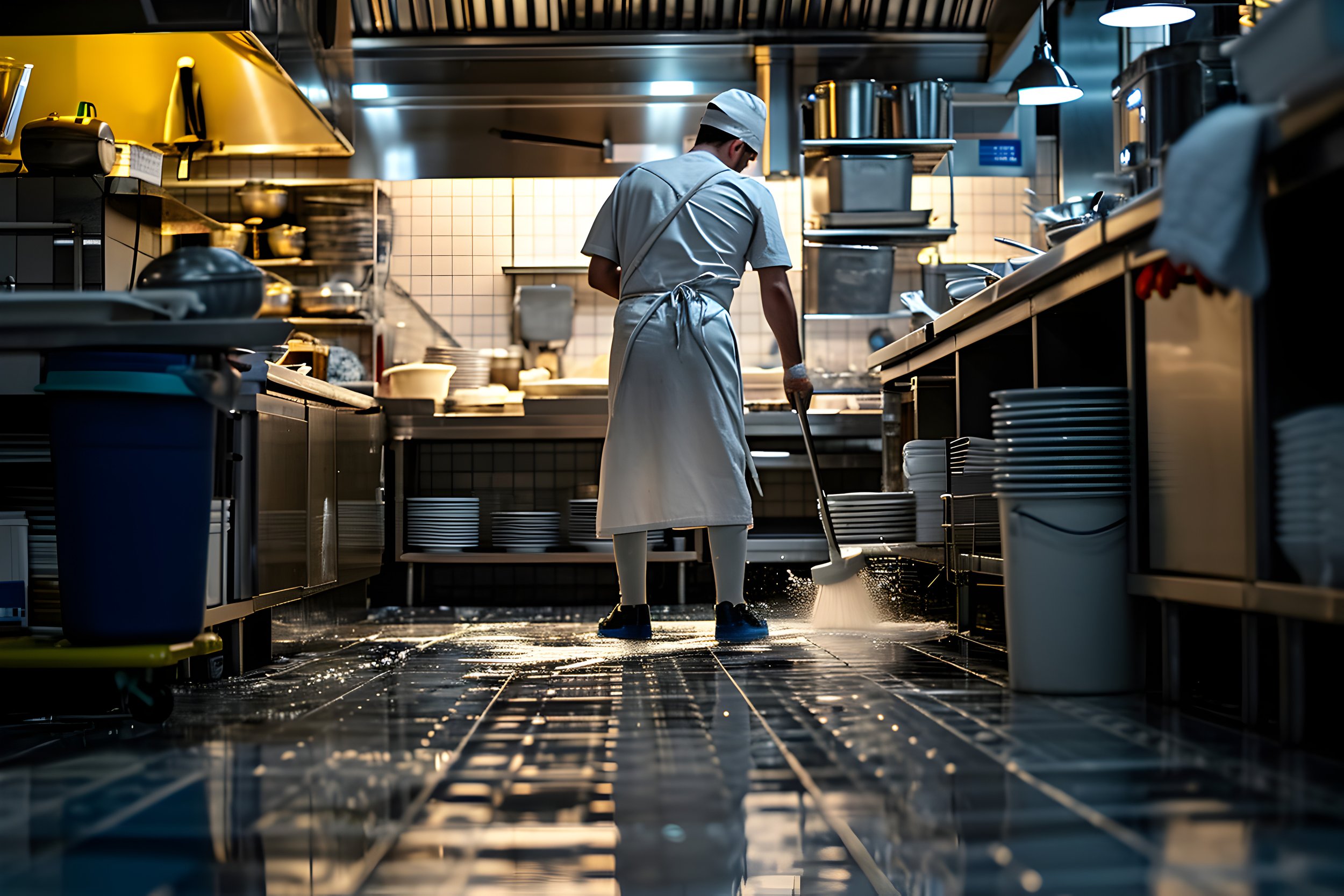
OUR EXPERIENCED TEAM ANSWERS YOUR QUESTIONS ABOUT DISH MACHINES
Because your customers count on you, you can count on us.
FAQs
Have more questions? Our team of knowledgeable experts will help you choose the right commercial dish machine for you. You can also read our blog for helpful tips on keeping your restaurant clean and running smoothly.
-
Leasing a commercial dishwashing machine instead of purchasing one offers several advantages, especially in terms of financial flexibility and maintenance. Here are some key benefits to consider:
Lower Upfront Costs
Leasing: Leasing typically requires little to no upfront investment. You pay a fixed monthly fee, which helps spread out the cost over time.
Owning: Purchasing a machine outright requires a significant initial investment, which can strain your cash flow.
Maintenance and Repairs
Leasing: Maintenance and repairs are often included in leasing agreements, meaning the leasing company handles the upkeep, repairs, and replacements. This saves time and reduces operational headaches.
Owning: When you own the machine, you are responsible for all maintenance and repair costs, which can add up over time, especially if the machine requires frequent service.
Upgrades and Flexibility
Leasing: Leasing allows you to upgrade to newer or more advanced models when your lease expires. This flexibility is useful as technology advances or your needs change.
Owning: Owning a machine limits your flexibility. If you want to upgrade, you have to sell the old one, which may not fetch a high resale value.
Tax Advantages
Leasing: Lease payments are often tax-deductible as an operating expense, which can provide tax benefits.
Owning: When you purchase a machine, you may only get tax deductions through depreciation, which is spread out over several years.
Cash Flow and Budgeting
Leasing: Leasing helps manage cash flow better because payments are predictable and spread out over time. This allows you to allocate funds for other business needs.
Owning: The upfront cost of purchasing could negatively impact your cash flow, especially if your business is just starting out or going through a slow period.
Risk Management
Leasing: Since the leasing company usually covers breakdowns and repairs, your business faces less risk of unplanned costs.
Owning: If the machine breaks down unexpectedly and you own it, you're responsible for costly repairs or replacement.
Reduced Obsolescence Risk
Leasing: With leasing, you can switch to newer, more efficient models more frequently, reducing the risk of using outdated equipment that may become inefficient.
Owning: Owning a machine could leave you stuck with outdated technology that doesn't meet the latest efficiency or environmental standards.
Trial Period
Leasing: If you’re uncertain about which machine will best suit your needs, leasing gives you the opportunity to try it before committing to ownership.
Owning: Buying a machine provides no trial period, and any miscalculation in your needs could be costly.
End of Useful Life
Leasing: At the end of the lease, you can easily return or upgrade the machine without worrying about disposal or resale.
Owning: Once the machine reaches the end of its useful life, you have to bear the cost and responsibility of disposing of it or finding a buyer.
Leasing a commercial dishwashing machine provides greater financial flexibility, removes the burden of maintenance and repairs, and reduces the risk of obsolescence. Owning, on the other hand, offers long-term cost savings if you plan to use the machine for many years and prefer to have complete control over the equipment. The best choice depends on your financial situation, operational needs and long-term plans. Our team can explain your options to help you make the best decision for your restaurant.
-
The primary differences between high-temperature and low-temperature commercial dishwashing machines involve how they sanitize dishes, their energy consumption, detergent usage, and some operational factors. Here's a comparison between the two:
Sanitization Method:
High-Temperature Dishwashers:
Use hot water (typically around 180°F or higher) to sanitize dishes.
The high heat kills bacteria and ensures that dishes are fully sanitized without the need for chemical sanitizers.
Low-Temperature Dishwashers:
Use lower water temperatures (around 120°F to 140°F).
Require chemical sanitizers (such as chlorine or iodine) to sanitize the dishes because the water temperature is not hot enough to kill bacteria on its own.
Energy Consumption:
High-Temperature Dishwashers:
Require more energy to heat the water to high temperatures.
Typically have a built-in booster heater to maintain the required temperature.
Low-Temperature Dishwashers:
Use less energy since they operate at lower water temperatures, making them more energy-efficient in this regard.
Drying Process:
High-Temperature Dishwashers:
The high heat causes the dishes to dry faster because the water evaporates quickly after the wash cycle.
This means less manual drying is required.
Low-Temperature Dishwashers:
Since the water is cooler, dishes may take longer to air dry and may require additional manual drying to prevent water spots.
Detergent and Sanitizer Use:
High-Temperature Dishwashers:
Use detergent designed to work with high temperatures.
Do not need chemical sanitizers as the heat provides the sanitation.
Low-Temperature Dishwashers:
Rely on chemical sanitizers (like chlorine) in addition to detergents to ensure proper sanitation.
You may need to monitor chemical levels more closely to ensure effective sanitization.
Cost:
High-Temperature Dishwashers:
Tend to be more expensive upfront due to the need for booster heaters and higher energy consumption.
May have higher operational costs because of energy use.
Low-Temperature Dishwashers:
Generally more affordable to purchase and operate in terms of energy consumption.
However, there are ongoing costs for chemical sanitizers.
Water Spotting:
High-Temperature Dishwashers:
Less likely to leave water spots, as the high heat dries dishes quickly.
Low-Temperature Dishwashers:
May leave more water spots if not properly dried, since the cooler water doesn’t evaporate as quickly.
Environmental Impact:
High-Temperature Dishwashers:
Higher energy consumption can result in a larger carbon footprint if not using energy-efficient systems.
Low-Temperature Dishwashers:
Reduced energy consumption is a plus, but the use of chemical sanitizers can have environmental impacts depending on disposal methods.
Maintenance:
High-Temperature Dishwashers:
Require more robust components to withstand high heat, which might lead to higher maintenance costs.
Low-Temperature Dishwashers:
May need more frequent attention to chemical sanitizers and proper calibration to ensure sanitation standards are met.
So which machine is best for your restaurant? High-temperature dishwashers are better for faster drying, no chemical sanitizers, and superior cleanliness but come at a higher energy cost. Low-temperature dishwashers are more energy-efficient and cheaper upfront but rely on chemicals and may have longer drying times. Our team can help you select the best machine based on your restaurant operation, staffing and financial considerations.
-
Health department requirements for commercial dishwashing machines are designed to ensure that food-contact surfaces, including dishes, utensils, and cookware, are sanitized properly to prevent foodborne illness. These requirements can vary by jurisdiction, but some general guidelines are typically enforced across many regions. Here are some key requirements for commercial dishwashing machines:
Water Temperature:
High-Temperature Machines: Must reach a minimum of 180°F (82°C) at the final rinse to properly sanitize dishes. This temperature ensures that bacteria and pathogens are killed.
Low-Temperature Machines: Use chemical sanitizers (such as chlorine, iodine, or quaternary ammonium) at a final rinse temperature of 120°F (49°C). The sanitizer concentration must be monitored regularly to ensure proper effectiveness.
Cycle Time:
Commercial dishwashers must run long enough to properly clean and sanitize items. Health departments may set minimum cycle times to ensure the process is effective.
Sanitization:
Chemical Sanitizers: If a low-temperature machine is used, the sanitizing solution must meet the health department’s guidelines, often requiring specific concentrations of chemicals like chlorine (50–100 ppm), iodine (12.5–25 ppm), or quaternary ammonium compounds (150–400 ppm).
Machines should have an automatic dispensing system for detergents and sanitizers to ensure the right concentration is maintained.
Proper Air-Drying:
Dishes should be air-dried after washing. Towel drying is generally not allowed due to the risk of contamination.
Thermometer and Test Strips:
Dishwashing machines must have built-in thermometers to monitor the wash and rinse temperatures.
Test strips must be available to regularly check the concentration of chemical sanitizers in low-temperature machines.
Regular Maintenance and Cleaning:
Machines must be regularly cleaned to avoid the buildup of food residues, grease, or scale, which can impact the effectiveness of the cleaning process.
The unit should be serviced according to manufacturer specifications and health department guidelines to ensure that it is in proper working condition.
Proper Rack System:
Dishes and utensils should be arranged in such a way that water and sanitizer can reach all surfaces. The health department may require specific types of racks or loading configurations to ensure proper cleaning.
Signage and Operating Instructions:
In some regions, it is required that clear signage be posted near the machine showing operating procedures, especially for manual cleaning machines.
Inspections and Records:
Regular inspections by health officials are typical. Operators may be required to keep records of temperatures, sanitizer concentrations, and maintenance logs to demonstrate compliance.
Make sure to check your local health department or food safety regulatory body (such as the FDA or local authorities) for specific and up-to-date requirements, as these can vary by location and county.

Ready to join the Chemmark family?
Complete this form and we’ll contact you promptly to schedule a consultation. We look forward to earning your trust and your business.
